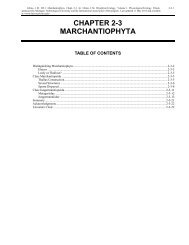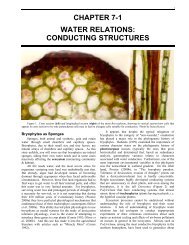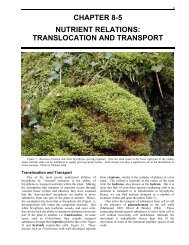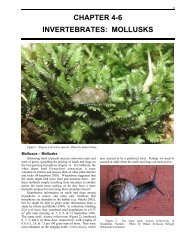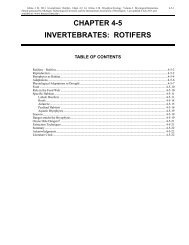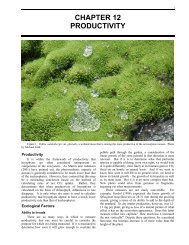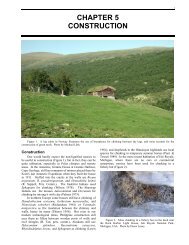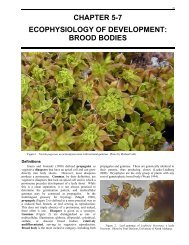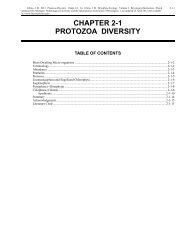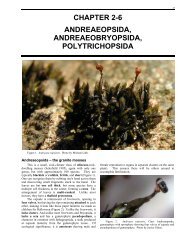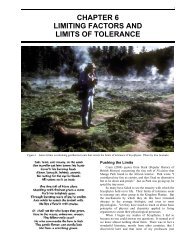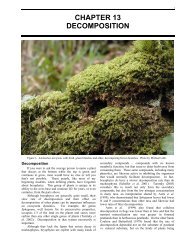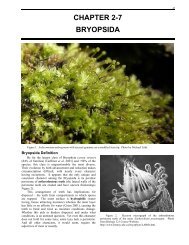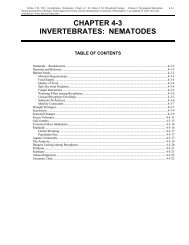Chapter 4-5: Adaptive Strategies - Bryophyte Ecology
Chapter 4-5: Adaptive Strategies - Bryophyte Ecology
Chapter 4-5: Adaptive Strategies - Bryophyte Ecology
Create successful ePaper yourself
Turn your PDF publications into a flip-book with our unique Google optimized e-Paper software.
50 <strong>Chapter</strong> 4-5: <strong>Adaptive</strong> <strong>Strategies</strong>: Growth and Life Forms<br />
In the Antarctic, aquatic mosses showed the greatest<br />
plasticity when submerged compared to being grown in the<br />
air (Priddle 1979). Calliergon sarmentosum grew longer<br />
stems (longer internodes) and larger leaves in the water,<br />
whereas Sanionia uncinatus varied little from its terrestrial<br />
form.<br />
Deserts<br />
It is significant that Frahm (1978) found only 9% of<br />
the bryophyte flora of the Sahara to be pleurocarpous. In<br />
the moist boreal forest, pleurocarpous is the dominant<br />
form. Pleurocarpous mosses expose much more surface<br />
area to the drying atmosphere; rather, in the dry desert,<br />
small cushions and wefts (loosely interwoven, ascending<br />
shoots capable of growing out of the sand are better<br />
adapted to the dry and shifting substrate.<br />
Polar Regions<br />
Longton (1979b, 1982) followed the life forms that<br />
Gimingham and Birse (1957) attributed to the polar regions<br />
in attempting to compare the Antarctic to other polar areas.<br />
He considered four Arctic bryophyte habitats: wetlands,<br />
mesic communities, polar deserts, and bryophytedominated<br />
habitats. He considered wetlands to be<br />
dominated by the tall turf life form, with lesser<br />
representation of short turfs such as Seligeria polaris on<br />
small stones.<br />
Mesic communities had a wider range of life forms<br />
than the wetlands, but the tall turf was still a dominant,<br />
with short turfs and mat-forming species also among the<br />
dominants. Although Longton (1979b) recognized five<br />
habitat types among the mesic communities, these forms<br />
were generally common among all five mesic communities.<br />
However, in Iceland, the weft community joined the tall<br />
turf in prominence, along with mats of leafy liverworts.<br />
Furthermore, the birch woods there had abundant weft<br />
mosses.<br />
Gimingham and Smith (1971) showed that the<br />
Polytrichum alpestre and Polytrichastrum alpinum turfs<br />
lost water more slowly than Chorisodontium aciphyllum<br />
and Sanionia uncinatus in the same habitats, attributing this<br />
to the waxy cuticle on the former two. That P. alpinum<br />
loses only about 10% of its water when centrifuged<br />
suggests that most of its water is held internally compared<br />
to the 20% lost from Chorisodontium aciphyllum.<br />
The dry polar desert fellfields have cushions of both<br />
mosses and flowering plants, but other open areas have<br />
compact forms such as mats, carpets, and short turfs<br />
(Longton 1979b).<br />
The bryophyte-dominated communities are those<br />
unsuitable for most tracheophytes (Longton 1979b). These<br />
include boulders, cliffs, musk ox dung, and hollows where<br />
snowmelt is late. The latter supports large cushions and<br />
tall turfs with small flowering plants rooted among them.<br />
The liverwort Anthelia juratzkana (Figure 22) is common<br />
here. Small cushions form on boulders, cliffs, and other<br />
rocky habitats. Rock crevices harbor small mats and turfs.<br />
Large cushions form on stony and marshy ground near<br />
permanent rivers and streams, with few bryophytes in the<br />
streams themselves. Where bryophytes do occupy streams,<br />
they are mostly streamers and mats.<br />
Figure 22. Leafy liverwort, Anthelia juratzkana, forming<br />
black mounds on the surface. Photo by Michael Lüth.<br />
The most unique of the polar habitats are those<br />
enriched with nitrogen by animal dung and support dense<br />
communities of dung mosses (Splachnaceae). Bird perches<br />
and lemming burrows support short turfs of acrocarpous<br />
mosses (Longton 1979b). Soil fractures between the<br />
polygons support short turfs of cosmopolitan taxa such as<br />
Bryum argenteum, Ceratodon purpureus, Funaria<br />
hygrometrica, and Marchantia polymorpha.<br />
Racomitrium lanuginosum forms extensive heaths<br />
resembling very large cushions in areas where it can gain<br />
water from the saturated atmosphere (Longton 1979b). In<br />
areas with frequent precipitiation as well as mist, Sanionia<br />
uncinata forms moderately thick mats.<br />
In the Antarctic, stones and gravel of nearly level<br />
ground support short turfs and cushions (Longton 1979b).<br />
In addition to these, calcareous substrata may have mats.<br />
Rock crevices have short turfs, small cushions, and mats.<br />
Alpine<br />
Alpine habitats seem to support mosses that resemble<br />
miniature tracheophyte growth forms. Cushions are<br />
common, but also carpets cover the dirt and provide<br />
protection from erosion. In studying the Ukrainian<br />
Carpathian Mountain alpine region, Ulychna (1970)<br />
included, in addition to these, bunches, dendroid, and<br />
interlacements, the latter two primarily in the transition into<br />
forest.<br />
Studies Needed<br />
While these growth and life form relationships to<br />
habitat seem to be well supported by field studies of<br />
species present, there has been little attempt to demonstrate<br />
that the proposed water relationships actually benefit the<br />
bryophytes. Transplant experiments need to be performed<br />
that compare the water loss of the various forms in a range<br />
of habitats, as well as their survival in this adult form<br />
without<br />
the need for surviving an establishment stage.



